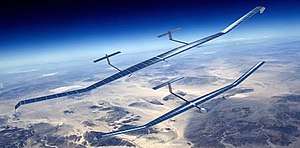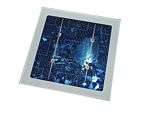Airbus Zephyr
The Airbus Zephyr is a series of lightweight solar-powered UAV.
| Airbus Zephyr | |
|---|---|
 | |
| An artist's impression of the UAV | |
| Role | High-Altitude Long Endurance unmanned aircraft |
| National origin | United Kingdom |
| Design group | initially Qinetiq, now Airbus Defence and Space |
| Introduction | 2017 |
| Status | 4 being built, 3 in service |
| Number built | 3 |
Development
The Zephyr was originally designed and built in 2003 by the British Defence contractor, QinetiQ.[1]
In a 2008 demonstration for the US military, a smaller-scale version of the Zephyr (Zephyr 6) performed beyond the official world record for the longest-duration unmanned flight, however its 82-hour flight at an altitude of 61,000 ft (19,000 m) did not set an official record because FAI officials were not involved in the flight.[2]
The Zephyr 7 holds the official endurance record for an unrefuelled, unmanned aerial vehicle with its flight from 9 to 23 July 2010, lasting 336 hours, 22 minutes and 8 seconds. It could also remain airborne for months thanks to its solar cells and rechargeable batteries.[3][4][5]
Record claims have been verified by the Fédération Aéronautique Internationale (FAI) for both duration[4] and altitude, at 21,562 meters. It more than doubled the previous endurance record for unmanned flight.[6][7][8]
The Zephyr system was sold to EADS Astrium (now Airbus Defence and Space) in March 2013 where it was successfully re-flown as part of the High Altitude Pseudo-Satellite (HAPS) programme.[9][10]
In 2014 it flew for 11 days in winter,[11] and later near civilian airspace.[12]
In November 2015, in the House of Commons, British prime minister David Cameron laid out plans during the Strategic Defence and Security Review 2015, to further enhance Great Britain's intelligence, surveillance and reconnaissance (ISTAR) capacity. In the speech, he stated that the UK was to field a 'British-designed unmanned aircraft that will fly at the edge of the earth's atmosphere and allow us to monitor our adversaries for weeks on end, providing critical intelligence for our armed forces." A purchase of two Zephyr-8's was reported in February 2016.[13] In August 2016 Ministry of Defence confirmed the purchase of a third Zephyr 8 platform.[14]
In Summer 2018 for its maiden flight from Arizona, the Zephyr S remained aloft for 25 days 23h 57min, nearly twice as long as the previous record flight of 14 days set by its predecessor.[15] It used Amprius lithium-ion batteries with silicon nanowire anodes for a 435 Wh/kg specific energy up from 300-320 Wh/kg for conventional graphite anodes.[16]
In addition to Zephyr 8, otherwise known as Zephyr S, full-scale flight testing is scheduled for a twin-tailed Zephyr T variant in 2018 aimed at providing a maritime surveillance and communications capability.[17]
Design
The Zephyr 6 is of carbon-fibre construction, and uses sunlight to charge a lithium-sulphur battery during the day, which powers the aircraft at night. The aircraft has been designed for use in observation and communications relay.[18]
The vehicle can circle over a particular area for extended periods with particular emphasis on its potential civil and military applications as an Earth observation and communications platform. During the day, Zephyr uses its solar cells spread across its wings to recharge high-power lithium-sulphur batteries and drive two propellers. At night, the energy stored in the batteries is sufficient to maintain Zephyr in the sky. The lithium sulphur batteries are supplied by Sion, and the first version had a battery capacity of 3 kW·h.[19][20]
Zephyr 7 was larger at 53 kg[21] and capable of a maximum altitude between 65,000 and 70,000 feet,[22] it required five ground crew to launch, as opposed to three previously for the Zephyr 6.[23]
The Zephyr 8 will have roughly 24 kg of batteries and a 5 kg payload,[13] and be 30 percent lighter and carry 50 percent more batteries than the Zephyr 7.[24] It has a 28-metre wingspan.
Specifications
| Model | Zephyr 6 | Zephyr 7 | Zephyr 8 (Zephyr S) |
|---|---|---|---|
| Crew | None | ||
| Payload | 2.5 kg (5.5 lb) | 5 kg (11 lb) | |
| Batteries | 24 kg (53 lb) Amprius lithium-ion | ||
| Span | 22.50 m (73 ft 10 in) | 28 m (92 ft) | |
| MTOW | 53 kg (117 lb) | ||
| Motors | 2× Newcastle University custom permanent-magnet synchronous motor | ||
| Power | 0.45 kW (0.60 hp) each | ||
| Cruise | 30 kn (56 km/h) | ||
| Ceiling | 21,562 m (70,741 ft) | ||
| Endurance | 3.4 days | 14 days | 26 days |
Accidents and incidents
As of May 2020, one hull loss has been reported. Numerous redundancies followed. [25][26]
See also
- NASA Pathfinder
- SoLong
- Solar Impulse project
- Vulture (UAV)
- Air Strato
Notes and references
- Amos, Jonathan (24 June 2003). "Strato-plane looks forward". BBC News.
British engineers are preparing to push the limits of aeroplane technology
- Amos, Jonathan (24 August 2008). "Solar plane makes record flight". BBC News.
- Amos, Jonathan (23 July 2010). "'Eternal plane' returns to Earth". BBC News.
- "FAI Record ID No. 16052". Fédération Aéronautique Internationale. Archived from the original on 4 April 2014. Retrieved 4 December 2012.
- "UK drones to spy from the stratosphere | The Times". The Times. Retrieved 4 February 2016.
- Hanlon, Mike (23 July 2010). "QinetiQ Zephyr solar powered unmanned aircraft to land after 14 days aloft". GizMag. Retrieved 4 December 2012.
- Amos, Jonathan (17 July 2010). "Zephyr solar plane flies 7 days non-stop". BBC News.
- Amos, Jonathan (14 July 2010). "Zephyr solar plane set for record endurance flight". BBC News.
- "First flight of Astrium's Zephyr solar HAPS". Airbus. Archived from the original on 5 October 2013. Retrieved 31 March 2014.
- "United Kingdom Ministry of Defence places order for two solar-powered Airbus Zephyr 8s". Airbus. Archived from the original on 13 January 2017. Retrieved 13 February 2017.
- Tovey, Alan (31 August 2014). "Fly 11 days non-stop? Now that's long-haul". Daily Telegraph.
- Bellamy, Woodrow III. "Airbus Zephyr Proves Value For Civil Operations in Middle East" Aviation Today, 1 October 2014. Accessed: 2 October 2014.
- " MoD to buy high-flying solar planes" Feb 2016
- "MOD buys third record-breaking UAV". UK MOD. 17 August 2016. Retrieved 17 August 2016.
- Dan Thisdell (8 August 2018). "Airbus sets flight endurance record with Zephyr UAV". Flightglobal.
- Graham Warwick (13 December 2018). "Record-Breaking Zephyr's Battery Holds eVTOL Potential". Aviation Week & Space Technology.
- "Farnborough 2016: Airbus releases Zephyr T details, outlines CONOPS for systems". Janes. 14 July 2016. Archived from the original on 25 August 2016. Retrieved 31 August 2016.
- QinetiQ Group (14 September 2008). "Zephyr - QinetiQ High-Altitude Long-Endurance (HALE) Unmanned Aerial Vehicle (UAVs)". Archived from the original on 26 August 2008.
- QinetiQ Group (16 July 2010). "QinetiQ's Zephyr solar powered unmanned aircraft soars to new world records". Archived from the original on 23 July 2010. Retrieved 17 August 2010.
- Bush, Steve (28 September 2007). "Inside Qinetiq's Zephyr solar powered plane". Electronics weekly. Archived from the original on 22 January 2013. Retrieved 4 December 2012.
- "Wing-to-tail guide to Zephyr, the 'eternal' plane". BBC News. 23 July 2010.
- http://www.defensenews.com/story/defense/air-space/isr/2016/02/17/british-mod-acquires-solar-powered-zephyr-uav/80513364/
- Goodier, Rob (7 July 2010). "Solar Plane Aims for New Record: 3 Months Aloft Without a Pilot or Fuel". Popular mechanics. Retrieved 4 December 2012.
- Ministry of Defence places order for two solar-powered Airbus Zephyr 8s. Feb 2016
- "Collision with terrain involving Airbus Zephyr unmanned aerial vehicle, near Wyndham Airport, Western Australia on 28 September 2019" ATSB, 02 December 2019. Retrieved: December 24, 2019.
External links
- Official website
- Ben Sampson (17 July 2018). "Zephyr S high-altitude persistent drone could achieve 100-day flight during tests". Aerospace Testing International.
